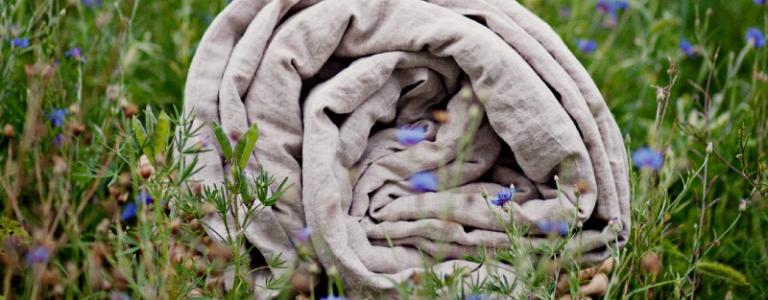
Linen — a gift from nature
Paskelbta: 2017-02-02Linen has a long history starting in ancient Egypt, where people have depicted the processing of linen on the wall paintings. Ancient Egyptians were using linen for clothing in order to protect themselves from the heat. Linen was the main fabric wrapping around the mummies of the pharaohs. What is more, linen was even mentioned in the Bible for several times, which convinces that this fabric was appreciated thousands of years ago.
Later flax became extremely popular in Europe because of its easiness to grow and maintain, because flax flourishes best in humid and relatively cool climates, in soil that is well-plowed. Learning to produce linen fabric out of flax was a major turning point in textiles for Europeans - they started to use linen for various domestic uses, such as table and bed coverings or clothing. Linen became the most important textile material until eighteenth century and was regarded for its quality.

There are four main steps to manufacturing linen material: cultivating, harvesting, releasing the fiber from the stalk and spinning. First of all, usually in the spring, flax seeds are shallowly planted and grows for about 100 days before they are harvested. Harvesting time is indicated when the leaves of flax wither, the seeds turn brown and the stem turns yellow. Any delay of the harvesting may result a negative effects on the quality of linen. Moreover, flax stalk must be removed from the soil very carefully, because it may also affect the quality of the linen. After harvesting flax stalks are processed using coarse combs and water. Then flax plants are dried, broken and scutched. After these processes the fibers are combed and straightened. Final step in manufacturing linen is spinning. Same length line fibers are combined and passed through a set of rollers making linen rovings, which are drawn out into a thread and wound on spools. Linen fiber must be processed in a humid and warm atmosphere, in order to be moisturized. This step is needed to reach the best quality of binding fibers. Finally, linen is taken to the dryers and wound on the bobbins, which make yarns ready for the weaving into fabrics.

Linen is very popular for bed sheeting, because of its amazing properties, such as freshness and coolness in a hot climate. It is extremely durable and lasts decades when cared for correctly. You’ll notice how naturally cool and smooth to the touch linen feels. Depending on the weather and temperature, linen can retain moisture or repel it without feeling damp. This is the reason why linen insulates in the winter and cools down in the summer. This fabric guarantees the sensation of well-being.
The flax fiber is naturally strong, soft and light. Linen fabric made from these fibers is breathable, durable and is the strongest of the vegetable fibers. Linen compared with cotton has 2 to 3 times more strength, although the more used and washed linen softens. What is more, linen does not cause allergies and eliminates many kinds of skins irritations, so it is extremely useful for people who are sensitive.

For your best comfort we washed and softened linen before turning it into covers. Our handmade bedding will provide you unrevealed feeling of luxury, coziness and quality sleep when you lay between “Labos Nakties” linen sheets.
Nature has created a wonderful gift — flax. Human handwork turned it into a unique fabric — linen. Accept this gift.
Source: http://www.encyclopedia.com/sports-and-everyday-life/fashion-and-clothing/textiles-and-weaving/linen